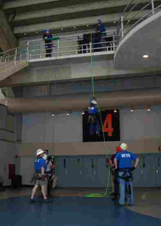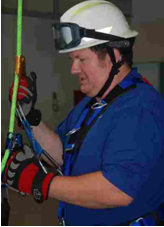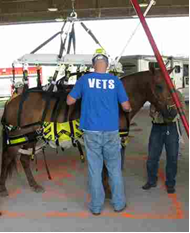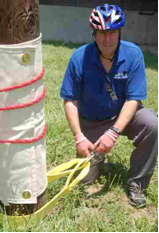|
[top]
Technical-Rescue-for-Large-Animals: Course Follow-Up
“Not the TLAER class,?John Haven noted in the August SART Sentinel. “This is a rope rigging and mechanical advantage class that takes the TLAER concepts to the next level. It is Rope Rescue - Operations Level.
So did the August 25 to 29 course deliver? Here is what Haven, who is Director of the U.F. School of Veterinary Medicine in Gainesville, said when it was all over:
“We’ve worked very hard to expand the capabilities of our Disaster Response Team. We not only have a deployable veterinary field hospital, but we have technical rescue capabilities as well. All of our team members are volunteers: staff, students, technicians, clinicians, and administrators from the School of Veterinary Medicine plus members of the state-wide Veterinary Reserve Corps. Recent training included rappelling, rope climbing techniques, and use of an “A-Frame?to lift a 1400-pound horse. Ultimately, the team should be a terrific resource for disaster response through the area Incident Command System. A secondary benefit is that participating students will carry skills into their local communities once they graduate.
|
[top]
FDACS/WIFSS Offer Agroterrorism Courses
“FDACS’ Office of Agricultural Emergency Preparedness is partnering with the Western Institute of Food Safety and Security (WIFSS) to sponsor DHS Certified Agroterrorism Courses during October 2008.
| |
|
 |
The Ramsey County
Minnesota Sheriff's department
and St. Paul police SWAT
teams in exercises at the St.
Paul Regional Water Services
sludge field. (photo NCBRT)
|
|
AWR-151 “Awareness: Understanding the Dangers of
Agroterrorism?
|
Tuesday, October 7 in Tallahassee from 1:00 to |
| |
5:00 PM |
|
Wednesday, October 8 in Macclenny from 8:00 |
| |
AM to Noon |
|
Thursday, October 9 in Plantation from 1:00 to |
| |
AM to Noon |
| |
|
AWR-151 “Awareness: Understanding the Dangers of
Agroterrorism?
|
Tuesday, October 14 in Homestead from 9:00 AM |
|
| |
to 4:00 PM |
|
Wednesday, October 15 in Belle Glade from 9:00 AM to 4:00 PM |
|
Thursday, October 16 in Seffner from 9:00 AM to 4:00 PM |
(AWR-151 is recommended, but not a required pre-requisite for AWR-152.)
To register or for additional information go to the WIFSS websites:
Registration: http://wifss.ucdavis.edu/agroterrorism/classes/classesbydate.php
To register or for additional information go to the WIFSS websites:
Registration:
http://wifss.ucdavis.edu/agroterrorism/classes/classesbydate.php
Thanks to a DHS grant through WIFSS, all courses are free notes Art Johnstone,
Director of the Office of Agricultural Emergency Preparedness. Johnstone may be
reached at his office (850) 410-6758 or via his mobile phone (850) 251-4184.
[top]
|
Through The Grapevine
2008 in Review ?Looking to 2009
FDACS?David Perry says that SART-related instruction in I-300 “Intermediate ICS
Command?has trained about 60 people in 2008, from members of the VETS Corps
to cooperating partners. Perry and John Haven, Director of UF’s Veterinary Medical
College, are the course’s primary instructors, both having been trained at FEMA’s
Center for Domestic Preparedness (http://cdp.dhs.gov) in Anniston, Alabama.
For 2009, Perry and Haven are tentatively planning several courses in I-400,
“Advanced ICS-Command and General Staff.?Who should consider taking the I-400
course? According to FEMA, “All federal, state, local, tribal, private sector and non-
governmental personnel should take ICS-400, including: Persons who will serve as
command or general staff in an ICS organization, select department heads with multi-
agency coordination system responsibilities, area commanders, emergency
managers, and multi-agency coordination system/emergency operations center
managers.?br>
For additional information about ICS courses scheduled or considered, please
contact David Perry (perryda@doacs.state.fl.us)or John Haven
(havenj@vetmed.ufl.edu).
|
[top]
Disaster Clean-up Safety ?Carbon Monoxide Hazards
Large-scale flooding, such as the flooding caused by Hurricane Katrina or the recent
floods in Florida caused by Tropical Storm Fay, demands large-scale clean-up. This
often means bringing power equipment into interior spaces. If the equipment is
powered by gasoline or electricity supplied by an on-site generator, there is a risk of
carbon monoxide build-up.
|
|
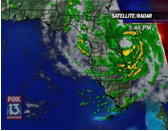 |
August 20th: Tropical Storm
Fay drenches Florida. (photo NCBRT)
|
|
- In late June, 13 workers cleaning a building in Cedar Rapids, Iowa, were overcome by carbon monoxide.
- A few weeks before that, 16 workers at Mercy Medical Center were poisoned by carbon monoxide because of a generator that was not adequately ventilated.
- The CDC* publication, MMWR (Mortality and Morbidity Weekly Report) noted several similar incidents in the weeks following Hurricane Katrina.
CO poisoning has become a regular feature of post-hurricane periods as more people purchase generators, but any situation in which people lose power for any length of time sets up the same problem. |
People often do not realize what adequate ventilation requires:
| 1. |
Never operate a generator or other gas-powered |
| |
equipment in an interior space. |
| 2. |
Never operate a generator or gas-powered equipment |
| |
near an air intake or under a window where exhaust |
| |
fumes may be drawn into a structure. |
| 3. |
Avoid working downwind of the exhaust from a gas- |
|
|
 |
| |
powered engine ?even in the open-air, as continuing exposure to carbon |
| |
monoxide can lead to poisoning. |
* Centers for Disease Control & Prevention (www.cdc.gov) |
[top] |
Hurricane Quick Quiz
1.
2.
3.
4.
5.
|
Names for tropical storms and hurricanes repeat every ______ (how many)
years.
Pre-approved names for storms are generated by ______ (who or what
agency).
The name “Katrina?was officially retired after the hurricane by that name
devastated New Orleans in ______ (what year).
Hurricane winds spin ______ (which direction) in the Northern Hemisphere
and ______ (which direction) in the Southern Hemisphere.
Instead of “hurricane,?the term ______ is used in the Bay of Bengal and
Arabian Sea; the term ______ is used in the Pacific Ocean north of the
equator and west of the International Dateline
|
|
6.
7.
|
At what wind speed does a tropical
storm officially become a
hurricane? (mph)
The "Pets Evacuation and
Transportation Standards Act"
requires emergency preparedness
plans to address the needs of
individuals with household pets and
service animals following a major
disaster or emergency. What year
was it signed and which president
signed it into law? (year and
president’s name)
|
 |
Can you name the hurricane that caused
this damage? It was the second Category 5
storm to make landfall in Florida in the 20th
century.
|
|
8.
9.
10.
|
SART is a ______ (type of organization) consisting of governmental and private
entities dedicated to all-hazard disaster preparedness, planning, response,
and recovery for the animal and agriculture sectors.
Hurricane Andrew struck Florida in ______ (year). It was a Category ______
(number) storm, only the third of that strength to hit the U.S. in the 20th
century.
Which of the following does the National Weather Service believe has strong
potential for changing the behavior and patterns of hurricanes?
a. tactical nuclear explosions in the eye of the storm,
b. seeding clouds with crushed “dry ice,?br>
c. towing icebergs into the paths of the storms,
d. using giant portable wind turbines along the shoreline to re-direct
airflow or
e. none of the above. |
Bonus (True or False): I a comfortable that my county’s emergency preparedness
plan adequately addresses the fact that approximately two out of three county
residents own pets.
|
The correct answers are listed at the end of this month’s Sentinel.
|
[top]
Volusia County’s Colleges Collaborate to Benefit All
By Richard Moore, Planner II
Volusia County Emergency Management
|
The colleges and universities in Volusia County are diverse. Three of the five are
private and two public. One is a renowned African-American institution and another is
a world leader in aviation. When it comes to serving the community and protecting
their students and staff, however, all are united.
Several years ago the five presidents of Bethune-Cookman University, Daytona State
College (formerly Daytona Beach Community College), Embry Riddle Aeronautical
University, Stetson University, and the University of Central Florida formed the Volusia
Flagler Higher Education Consortium. One of Daytona State’s six campuses is in
Flagler which brings that county into the mix. The Consortium strives to address
mutual interests.
Following a tabletop exercise conducted for the college presidents and their key staff
by Volusia County Emergency Management two years ago, a decision was made to
form a committee to address continuity of operations during a pandemic disease
outbreak. Representatives from all of the institutions worked with Volusia County’s
Health Department and Emergency Management for more than a year to develop a
cooperative template for such things as student health care, feeding and
housing of resident students, and class continuity. Each campus can modify the
template to meet its needs.
|

August 18, 2008: NOAA’s satellite photo shows
Tropical Storm Fay nearing Florida. The storm
dropped unprecedented amounts of rain on east
central Florida resulting in significant flooding |
|
Following another Emergency Management tabletop held at Embry Riddle this summer, the presidents set a new goal. While the earlier committee focused on individual campus continuity, the goal now is on inter-campus mutual aid. Sharing classrooms and other educational facilities as well as supporting services such as dormitory space and food services, is the goal of the new effort. Focus areas include housing, security and information technology. Eventually mutual aid agreements will be developed for each focus area.
Yet another development is the formation of the Consortium Security Group. It will meet quarterly
|
to discuss such issues as handling disruptive students, exchanging
intelligence on graffiti, and other visual displays. The group will include a representative of Volusia County Emergency Management, law enforcement, emergency medical services, and other response organizations.
The participating colleges have bridged a wide gap. They not only talk to each other,
they work and plan together. The community at large and the students in particular
are the beneficiaries.
|
[top]
Emergency Planning for Fruit & Vegetable Growers
Developed by John Shutske, University of Minnesota Extension Service, “What’s Your Emergency Response Plan IQ (http://safety.cfans.umn.edu/ERPIQ/workbook.html)provides a workbook and other materials to help fruit and vegetable growers prepare for emergencies. Shutske’s program is targeted to agriculturalists who sell products locally to farmer’s markets, through pick-your-own initiatives, and similar outlets. It includes two informative video clips that compare the same growers, first, with no plan and, second, with a plan and thorough documentation.
(Thanks for the tip to Dr. Carol Lehtola of the Department of Agricultural
and Biological Engineering and Safety News & Notes.)
|
 |
Dr. John Shutske,
Univ. of Minnesota |
|
|
[top]
And Now…Firewood
Whether you pitch a tent, park an RV or just unroll a pack, at the end of the day there's always a campfire. And, there is no campfire without firewood, says GoodCamper.info.
Recently firewood has become a big concern due to the discovery of the emerald ash borer, an invasive beetle that kills ash trees. |
|
The borer is an enormous threat to North America's urban and rural forests and is so aggressive that ash trees may die within two or three years after
becoming infested.
People unknowingly contribute to the spread of the borer when they move firewood. Larvae can survive underneath the bark of ash firewood, and when it's moved from one place to another, the borer can hitchhike to a new location…a favorite
|

|
States in green are those which the spread of the
Emerald Ash Borer has caused difficulties for
campers and for use and movement of firewood.
|
|
campground, state park, or wilderness
retreat.
According to USDA-APHIS, campers can help prevent the spread of Emerald Ash Borer and gives the following tips:
Don't move firewood.
Always keep firewood within the county and if purchased, know the source.
If you camping or hunting, buy firewood at your destination. Do not accept firewood from EAB-infested states.
Know Federal & State regulations regarding the movement of firewood.
|
For more information about the Emerald Ash Borer go to www.goodcamper.info.
[top]
CDC Launches Program to Train Veterinarians
First-ever program for CDC includes hands-on experience in high-containment labs
|
Because America needs veterinarians certified to work with laboratory animals, the Centers for Disease Control and Prevention (CDC) has begun a residency program in laboratory animal medicine. It combines classroom training with hands-on experience in high-containment labs to prepare veterinarians for careers in biomedical research. (www.cdc.gov/media/pressrel/2008/r080829.htm)
|
|
“It is a struggle to find experienced veterinarians interested in laboratory animal medicine. With more high-containment labs being constructed, the problem is going to get worse,?said Dr. Carolyn Black, director of the CDC's Division of Scientific Resources.
The two-year program is a partnership between CDC (www.cdc.gov) and Emory University’s Robert W. Woodruff Health Sciences Center (www.whsc.emory.edu). The program combines 200 hours of academic courses at Emory with 2,000 hours of in CDC's labs with a CDC scientist as a mentor. Applications for the 2009 class of 2-3 individuals will be accepted in November.
Graduates will be proficient in day-to-day care and treatment of laboratory animals as well as working in high-containment laboratories (Biosafety Levels 3-4), designing scientific experiments and the use of animal models and administration of lab animal medicine programs.
|
The program is accredited by the American College of Laboratory Animal Medicine (ACLAM: www.aclam.org). Individuals who successfully complete the program will meet the training requirements needed to take ACLAM's certifying examination. Trainees will work at CDC for at least two years following the program.
Candidates must have a Doctor of Veterinary
|
Medicine degree or the equivalent from an AVMA-accredited veterinary school, be a U.S. citizen or hold permanent residency status and be eligible to obtain and maintain a U.S. government security clearance.
[top]
Florida Horse Park Makes Pitch to Advisory Board
The September course, Preparedness and Response to Agricultural Terrorism, sponsored by Marion County and The Villages Fire Rescue was cancelled due to the potential impact of Hurricane Ike because Hurricane Ike was initially forecast to make landfall in Florida.
“We made a last minute call to LSU before the instructors flew out on Monday,?says Ken Smithgall, CFO, Battalion Chief, Special Operations for Marion County Fire-Rescue. The training was to have been provided by Louisiana State University’s National Center for Biomedical Research and Training.
“The Friday morning forecast showed Hurricane Ike coming straight up through South Florida so we opted to postpone. The program will be rescheduled. Those that responded to the initial
|
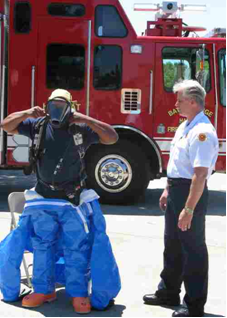
Forensics course walk-through shows
donning of ppe. (photo NCBRT)
|
|
posting were mainly hazmat teams and law enforcement. We didn't have the wide variety of attendees that I was hoping for. This program is really for agricultural people and those associated with or supporting their response. We will be working closely with SART to get the word out to a wider audience for the rescheduled program."
Ken Smithgall may be contacted at kenneth.smithgall@marioncountyfl.org or (352) 291-8000.
[top]
Mission Statement ?NCBRT at LSU
|
The mission of the National Center for Biomedical Research and Training (NCBRT) is to help America prevent, prepare for, respond to, and recover from acts of domestic and international terrorism, weapons of mass destruction, and high-consequence events through teaching, training, technical assistance, and research.
|
|
[top]
About the SART Sentinel
|
Editor: Rick Sapp, PhD, Technical Writer, Florida Department of Agriculture & Consumer Services, Divisiond of Animal Industry [rsa5@cox.net]
Associate Editor: Joe Kight, State ESF-17 Coordinator, Florida Department of Agriculture & Consumer Services, Division of Animal Industry [kightj@doacs.state.fl.us]
The SART SENTINEL is an E-mail newsletter prepared monthly by Rick Sapp and the members of the Florida State Agricultural Response Team. Past issues of the Sentinel are archived on the Florida SART Web Site, www.flsart.org.
If you have a story or photo that you would like to have considered for publication in The SART SENTINEL, please contact the Editors.
|
[top]
Answers to "Quick Hurricane Quiz"
2. The National Hurricane Center generates lists of candidate names for storms.
3. The name ?u>Katrina?was retired following the 2005 hurricane season.
4. Hurricanes spin counter-clockwise in the Northern Hemisphere and clockwise
below the equator.
5. Hurricanes are called cyclones in the Arabian Sea and typhoons in the Pacific
Ocean.
6. At 74 mph.
7. President George W. Bush signed the “Pets Evacuation and Transportation
Standards Act?into law in 2006.
8. SART is a multi-agency coordination group consisting of governmental and
private entities dedicated to all-hazard disaster preparedness, planning,
response, and recovery for the animal and agriculture sectors.
9. Andrew struck Florida in August 1992 as a Category 5 hurricane. The others
were the Labor Day Hurricane of 1935 and Hurricane Camille in 1969.
10. None of the above. Destructive as they may be, hurricanes are part of a
natural cycle of heating and cooling of ocean water and any change to this
cycle would have unforeseeable consequences.
Bonus (True or False) If your county’s plan adequately addresses care and
evacuation of animals during and immediately following an emergency situation,
congratulations! If not, now is the time to get organized!
|
[top]
|
|
|

 Printer-Friendly PDF Version
Printer-Friendly PDF Version

